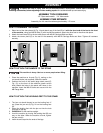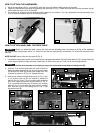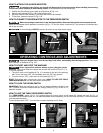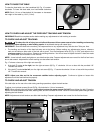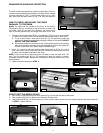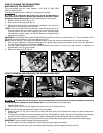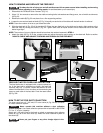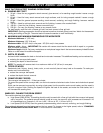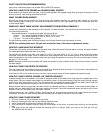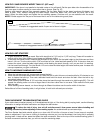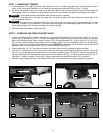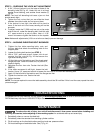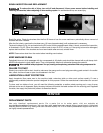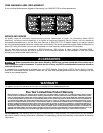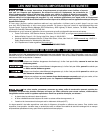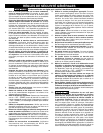15
DUST COLLECTION RECOMMENDATION
Use a dust collection system with at least 400 to 600 CFM capacity.
HOW DO I SAND FACE FRAMES and RAISED PANEL DOORS?
Some doors have boards with the grain running at 90 degrees. We suggest using finer grit paper, removing minimal
amount of stock, and slowing down the feed rate.
WHAT CAUSES BURN MARKS?
Burning the wood can be caused by several things. We suggest checking for; sanding belt overlap on the drum
wrap, sanding paper loading up, too much stock removal with too fine a grit paper, too slow a feed rate, and dull
or worn sand paper.
WHEN DO I MAKE TABLE HEIGHT ADJUSTMENTS FOR MATERIAL REMOVAL?
Locate the handwheel on the right side of the machine. To raise the table, turn the wheel counter-clockwise. To lower,
turn the wheel clockwise.
Normal adjustments for sanding belt grits 36 through 80 are:
1/4 turn – For normal material removal (1/64"or .0150") or (.4 mm)
1/8 turn – For normal finishing (1/128" or .0075") or (.2 mm)
1/16 turn – For last finishing passes
On last finishing passes, pass the board through two or three times to level hard spots or knots.
NOTE: For sanding belts over 100 grit use one half or less of the above adjustment values.
HOW DO I SAND MULTIPLE BOARDS?
The sander will handle multiple boards at the same time. Work with each individual piece until they are approximately
the same thickness, then sand them as a group.
The sander will accept more than one board at a time if the total width is 16" (41 cm) or less and are the same
thickness. Pass the first board. When it reaches the rear pressure roller, start another board on the other side of the
table. Depending on the width, several boards can go through the sander at one time. Do not sand the edge if boards
are over 4" (10 cm) wide.
NOTE: Because multiple board sanding will cause the sander to have a heavier load, either slow the feed or reduce
the table height.
HOW DO I SAND THE EDGES OF BOARDS?
First, be certain that the opposite side from the side to be sanded is even and level. If it is not, then it may need to be
cut. Sand the board, turn it over and sand the other side.
If the board is thin or tall when turned on its side, clamp several pieces of wood together to prevent tipping.
HOW DO I SAND CUPPED, BOWED, OR TWISTED BOARDS?
Cupped boards can be a problem. If the bow is along the width of the board, then first place the cupped side of the
board down. Set your sander table height to the tallest portion of the bowed board. Pass the board through several
times until a fairly good portion is flat. Turn the board over and sand the cupped side until the board has a small flat
area on each side. Alternate sanding on each side until you are satisfied with the result.
Bowed boards that are longer than the table cannot be cleaned sufficiently. However, if the board is table length or
shorter, set your table height to the maximum height of the board. Place the bowed side down and sand until you are
satisfied. Then turn the board over, and clean that side.
Twisted boards can be a difficult project. Small boards will provide some success, but longer boards are almost
impossible. However, for best results, alternate sanding first one side of the board, then the other.
HOW DO I SAND GLUED BOARDS?
1. Glue the boards as flat as possible at the outset.
2. Remove excess glue from the top and bottom before it dries.
3. Use a coarse belt for initial stock removal (36 to 60 grit).
4. Run the board at different locations over the entire length of the drum to prevent glue build-up on the sanding
belt.
5. After glued joints are cleaned, change the sanding belt to an 80 grit. Work your way to the finer grit until you
are satisfied with the result.



